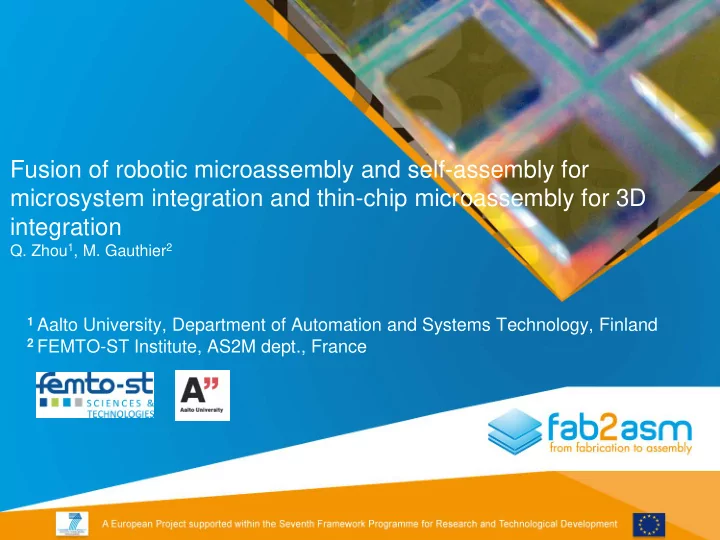

Fusion of robotic microassembly and self-assembly for microsystem integration and thin-chip microassembly for 3D integration Q. Zhou 1 , M. Gauthier 2 1 Aalto University, Department of Automation and Systems Technology, Finland 2 FEMTO-ST Institute, AS2M dept., France
Fusion of robotic microassembly and self-assembly Part 2: Thin-chip hybrid-assembly and dielectrophoresis self-assembly - Hybrid robotic and capillary self-assembly of ultra-thin dies - Hybrid robotic and dielectrophoresis self-assembly - Dielectrophoresis robotics
Thin-chip micro-assembly and dielectrophoresis self-assembly - Hybrid robotic and capillary self-assembly of ultra-thin dies - Hybrid robotic and dielectrophoresis self-assembly - Dielectrophoresis robotics 2/20
Ultra thin dies assembly : interest and challenges Applicative context: Global reduction of electronic dies thickness in back-end electronic industries - 2013 : around 40µm thick components - 2022 : thickness down to 10µm is expected 2012 2017 2022 Wirebond (µm, minimum thickness) 30 20 15 Through Silicon Via (µm, minimum 40 20 10 thickness) General problematics: Current methods deals with the positionning of die on adhesive tape for dicing before handling New method should be developed for ultra thin die 3/20
Design of breakable links Fabrication of wide panel of breakable links in SOI wafer Die size: 1mm x 1mm x 10µm (or 5µm) 4/20
Design of the breakable link Concept: exploit the weakness of silicon in torsion Design: take into account four level of force: - Force applied during fabrication process (0.3mN) - Force required to break the link (1mN) - Vaccum gripping force (10mN) - Force induced the break of the silicon components (250 mN) 5/20
Hybrid assembly station 7/20
Hybrid assembly of ultra-thin dies Assembly examples of 5µm and 10µm thick dies 4 ultra thin dies 20µm (thickness 5µm) 1 2 3 4 20µm 8/20
Thin-chip micro-assembly and dielectrophoresis self-assembly - Hybrid robotic and capillary self-assembly of ultra-thin dies - Hybrid robotic and dielectrophoresis self-assembly - Dielectrophoresis robotics 9/20
Dielectrophoresis principle ● DEP = non-uniform E+ dielectric object ● DEP system requirements ● Electrodes immerged in an liquid medium ● Electric voltages application ● Motion characteristics in DEP ● High nonlinearity ● High speed motion (~10ms) ● High precise final stable and controllable position evaporation force level DEP Capillarity 10/20
Objectives High speed and precision self-alignment High speed and precision self-assembly ● Original way: long range force field Dielectrophoresis. 11/20
Experimental setup 1 3 2 1- Computer 2- Acquisition card and voltage amplifier 4 3- Camera and optics 4- Electrodes and connectors 12/20
Self-assembly using electric field (DEP) Objective: using electric field for self-assembly Principle: Result: 100µm large dies self-assembly Self-alignment of the first die Self-assembly of the second die 13/20
Thin-chip micro-assembly and dielectrophoresis self-assembly - Hybrid robotic and capillary self-assembly of ultra-thin dies - Hybrid robotic and dielectrophoresis self-assembly - Dielectrophoresis robotics 14/20
Position control using DEP Programmable self-assembly principle ● Enhance the precision of the final position ● Using several assembly location Average assembly ● Requirements: time : 10 ms ● Non linear control law ● High speed real time control system ● Average assembly time : about 10’s ms Micro-actuation principle usable for 6DOF positionning 15/20
Non contact actuation: new generation of robots? Evolution of the movement transmission in production robots - 1961 : first robot ‘UNIMATE’ is used in General Motors - 80’s : first use of compliant joint in robots Robot throughput the smaller the object is, the bigger the impact of the inertia of the robot is: type Robot weight Objet weight ratio Car industry 600kg 30kg 20 E Microelectronic 10kg 5 g 2000 2.10 13 Meso-assembly 100g 5 pg microw owor orld nano nanoworld mesow owor orld 1nm 10nm 100nm 1µm 10µm 100µm 1mm dimensions of the objects 16/20
Non-contact mesorobotics Proposed approach - robots based on new movement transmission without inertia Objectives - to perform controled pick-and-place operation @ up to 100Hz - develop a new objective of miniaturisation: « assemble smaller components in order to assemble them faster » Scientific positionning - Closed-loop control of non contact manipulations - Parallel robotics on new actuators’ Manipulated obejcts Force field 40µm Source of field Non-contact Non-contact Parallel Manipulation mesorobotics Robotics 17/20
Open loop control using dielectrophoresis Open loop control only based on the model Test bench : controlling a 50µm bead trajectory square reference trajectory Results : replay Low speed (1s) High speed (0,1s) 18/20
closed loop control using dielectrophoresis Closed loop control based on the visual feedback : improvement of the robustness Results : Around 5µm dynamic error Slow motion replay Real time 19/20
Conclusion - Push the state of the art of stacked ultra thin dies from 40µm to 5µm - Proof of concept of dielectrophoresis hybrid-assembly - Proof of concept of closed loop non-contact mesorobotics 20/20
Acknowledgment FAB2ASM project Hybrid self-assembly and robotic assembly - High speed assembly - High precision Examples of results Assembly of 10µm thick dies (state of the art : 40µm) Assembly of 120x120 µm dies at 24kUPH (10 kUPH) 20µm
Fusion of robotic microassembly and self-assembly for microsystem integration and thin-chip microassembly for 3D integration Q. Zhou 1 , M. Gauthier 2 1 Aalto University, Department of Automation and Systems Technology, Finland 2 FEMTO-ST Institute, AS2M dept., France
Recommend
More recommend